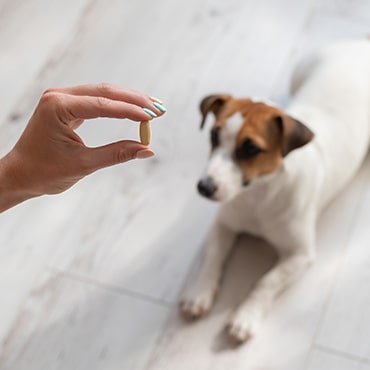Antibiotics for pets
Overview
- Antibiotics are medications that can be used to treat bacterial infections.
- There are many different types - some kill a range of bacteria (broad spectrum), and others only target certain groups (narrow spectrum).
- Antibiotics are extremely useful (sometimes lifesaving) medicines, but they need to be used carefully to prevent bacteria becoming resistant to them therefore making infections more difficult to treat.
- Antibiotics should always be reserved for the people and animals that need them the most.
- Antibiotics kill bacteria and are not useful for treating other germs such as viruses and fungus.
General information
Bacteria are all around us and are essential for life on earth, but in the wrong place, can cause infections and severe illness. Since antibiotics were discovered, infections have been much easier to treat, but it's important that we use them carefully otherwise bacteria will become resistant to their effects, making infections very difficult to treat.

How do antibiotics work?
Antibiotics kill bacteria by damaging their structure or preventing them from multiplying. Some antibiotics are capable of killing many different types of bacteria ('broad spectrum'), while others only kill very specific types ('narrow spectrum'). Antibiotics can be given by injection, tablet, capsule, drops, ointments and creams. Antibiotics do not kill other types of germ such as viruses or fungus.
Side effects
Antibiotic side effects are uncommon but can sometimes occur, and just like humans, some pets are allergic to some of them. Let your vet know if your pet has recently started antibiotics and develops any symptoms such as:
- Diarrhoea and / or vomiting
- A rash
- Swellings
- Low energy
- A reduced appetite.
It's particularly important to watch out for side effects if your pet is pregnant, very young, very old, or if they have any other illnesses (such as liver or kidney damage).
Antibiotic resistance
You have probably heard about ‘superbug’ bacteria such as MRSA. Superbugs are groups of bacteria that have become resistant to all known antibiotics, making them extremely difficult (sometimes impossible) to treat. The more antibiotics we use, the more bacteria get used to them and find ways to resist them. If we don't take measures to prevent antibiotic resistance, people and animals may struggle to fight even the simplest of infections in the future.
You can help to prevent resistance by following this guidance:
- Give the correct dose of antibiotic at the right time.
- Always complete your pet's antibiotic course (even if your pet seems better before it finishes)
- Never give your pet antibiotics unless they have been prescribed by your vet - the wrong antibiotic to the wrong pet for the wrong condition can cause more harm than good
- Give your vet any antibiotics that you aren't using. Never put them into the bin or down the toilet means you are releasing them into the environment and creating resistance.
When to contact your vet
Contact your vet if your pet has been prescribed antibiotics and their problem does not seem to be improving or if they have developed side effects.
You know your pet best. If they don’t have the symptoms listed above but you are still concerned it’s always best to contact your vet.
FAQs
Why didn’t my vet prescribe antibiotics?
If your vet didn’t prescribe your pet antibiotics, there is likely to be a good reason. There are many situations when antibiotics won’t cure the problem, for example if your dog has an infection caused by a virus or fungus. Always speak to your vet if you are worried - they will be happy to explain further.
How long will my pet need antibiotics?
Your vet will have put instructions on your pet’s antibiotics explaining how many to give, when and for how long. However, if you can’t see the instructions clearly always double check with your vet.
My pet seems better, can I stop his/her antibiotics?
No, always finish the course of antibiotics your vet has prescribed. If you fail to finish the course the infection may return, and the second time round, the infection could be much worse.
How much do antibiotics cost?
The cost of your pet’s antibiotics will depend on the type and dose they need (large pets tend to cost more to treat because they need bigger doses of medication).
My pet have just stopped their antibiotic and their symptoms have returned, what should I do?
Contact your vet for advice; your pet may need a longer course of antibiotics or further investigations.
Can I give my pet antibiotics without a prescription?
No, any antibiotic you give to your pet should be prescribed by your vet. Never give your pet a medication without instruction by your vet, even if they have had it in the past. Using an antibiotic in the wrong way can be harmful, create antibiotic resistance more severe problems for your pet in the future.
How should I give my pet their antibiotic?
All instructions should be on the packet but always contact your vet if you are unsure. Watch our videos on how to give your pet antibiotic tablets or eye drops.
Published: January 2021
Did you find this page useful?
Tell us more
Please note, our vets and nurses are unable to respond to questions via this form. If you are concerned about your pet’s health, please contact your vet directly.
Thank you for your feedback
Want to hear more about PDSA and get pet care tips from our vet experts?
Sign up to our e-newsletter
Written by vets and vet nurses. This advice is for UK pets only. Illustrations by Samantha Elmhurst.

